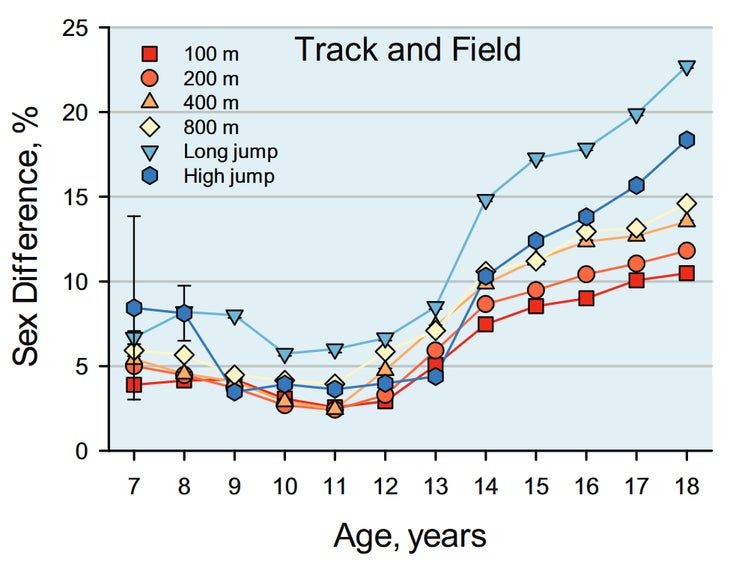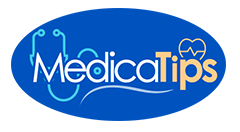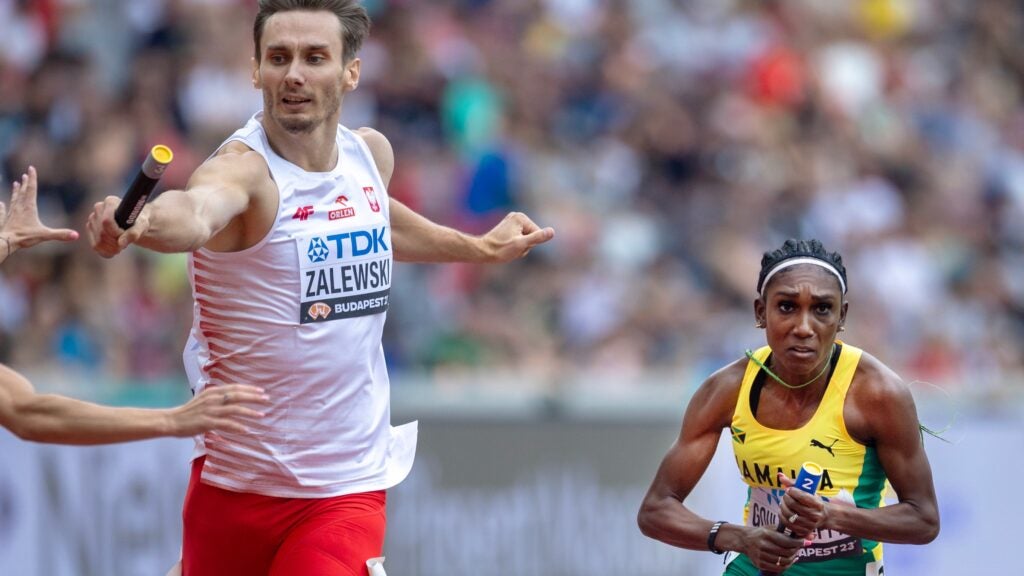Earlier this month, the Journal of Applied Physiology published a paper with the title “Evidence on Sex Differences in Sports Performance.” Seems pretty straightforward, but of course it’s not. The gap between male and female athletes has become a major flashpoint in debates on whether transgender women and athletes with differences of sexual development, like the South African runner Caster Semenya, should be able to compete in women’s sports.
Three scientists—Michael Joyner of the Mayo Clinic, Sandra Hunter of the University of Michigan, and Jonathon Senefeld of the University of Illinois Urbana-Champaign—present a series of seven statements on the topic of sex differences in sport, along with the evidence to support them. Some of them seem obvious, others less so. Whatever your opinion on the debate, I think it’s worth considering each of these statements (which I’ll paraphrase) in turn, in order to understand what the current evidence says and where the gaps are. The full paper, including references, is free to read here.
A note on terminology: the article deals with differences in sex rather than gender. Although it’s an oversimplification, I’ll use the terms male and female to refer to people with XY and XX chromosomes, respectively.
1. Males outperform females in events that depend on strength, speed, power, and endurance.
The evidence cited here is primarily performance data from sports like running, jumping, and weightlifting, where outcomes are easily measured. Among elite adults, the male-female gap is typically above 10 percent. The largest gaps are seen in sports that depend on explosive power, like high jump and long jump, where the gap approaches 20 percent. Field sports are harder to measure, but to the extent that they involve running and jumping and lifting, similar conclusions should apply.
Are these gaps biologically determined, or, as some scholars argue, the result of social factors like the limited opportunities for women in sport? Elite performance data, on its own, can’t answer this question. But there’s no question that the gap exists, and is nearly universal. There may be some exceptions in activities like extreme long-distance swimming, where the determinants of performance are more complex. Overall, though, this statement should be uncontroversial.
2. This male-female gap shows up before puberty.
This seems like a significant claim, because it suggests that males may have a performance advantage that isn’t erased even if a transgender woman has undergone hormone therapy to lower testosterone levels. The evidence, once again, is primarily from performance data. Take a look at this graph of age-group track and field results for boys and girls between 7 and 18 years old:

Between the ages of 7 and 9, boys seem to be ahead, on average, by 4 to 5 percent. The gap narrows between the ages of 10 and 12, presumably as girls start puberty earlier than boys. After the age of 13, male puberty gets going and the gap widens rapidly.
So what gives 8-year-old boys an edge? As Joyner and his colleagues acknowledge, it’s once again hard to distinguish between biological and social factors. There is a possible hormonal explanation. We undergo a “minipuberty” during the first few months of life, with a temporary increase in sex hormones that is associated with a subsequent increase in muscle and decrease in fat accumulation in boys. But it’s also true that boys tend to spend more time running and jumping in unstructured play, and this may reflect gendered social expectations rather than sex differences.
Overall, the small gap in pre-puberty performance doesn’t seem like strong evidence of ineradicable differences between males and females. Instead, it’s the subsequent shape of that curve that, as we’ll see, turns out to be more significant.
3. The gap widens with puberty, along with changes in body structure and function.
In the graph above, male-female differences accelerate dramatically after the age of 13 and continue all the way to adulthood. Now it gets harder to attribute the changes to social factors, because there are a host of other changes that accompany puberty and are associated with sports performance: males see a greater increase in muscle, airway and lung size, heart size, oxygen-carrying capacity of the blood, and so on.
Perhaps the most obvious difference is height: by the age of 20, the average male is taller than 97 percent of women. Differences in lung size or hemoglobin levels are invisible to us; differences in muscle mass could conceivably be because boys are encouraged to work out more. But height? We see it all around us, and accept that it’s driven by biological sex differences.
4. The main driver of the male-female performance gap in adults is the surge in testosterone during male puberty.
Here’s when things get more contested. Where, you might ask, is the randomized controlled trial proving that males who go through puberty without testosterone are worse athletes, or that females who go through puberty with male levels of testosterone are better athletes? Such studies haven’t been done, for obvious practical and ethical reasons.
Joyner and his colleagues argue that we can instead piece together the evidence from studies showing links between testosterone levels and increased physical performance during puberty; the various studies in humans and animals showing testosterone’s effects on muscle, bone, and blood parameters; doping studies where volunteers took testosterone; and strong circumstantial hints like the graph above showing the widening performance gap during puberty. The evidence here isn’t perfect, but as a whole it’s convincing.
5. Body changes during female puberty can have negative effects on sports performance.
This is an angle I hadn’t thought much about. The discussion usually focuses on the advantages conferred on males by testosterone, but there are a distinct set of changes that females experience during puberty. For example, they accumulate more body fat; their growth plates fuse so they stop growing taller; they develop breasts, which can alter balance and movement patterns; their hips widen, which may increase injury risk; they experience hormonal fluctuations associated with the menstrual cycle that may (or may not!) affect performance; they may eventually miss training time during pregnancy and face increased injury risk when returning to training after childbirth.
There’s no doubt that all these changes occur, and that they have the potential to influence performance. Whether they collectively make a significant contribution to the gap between male and female athletic performance is less clear. It’s worth considering, but I’d classify it as an open question for now.
6. Suppressing male testosterone levels after puberty only partly eliminates the male-female performance gap.
There’s a smattering of case studies and comparison studies to support this statement. A 2023 U.S. Air Force study in Military Medicine, for example, tracked fitness test scores for nearly 400 transgender servicemembers for up to four years after they began hormone therapy. For transgender females, performance on some tests, like the 1.5-mile run, ended up corresponding to average female times by the fourth year of hormone therapy. But for other tests like push-ups, there were still differences.
Here’s how push-up scores evolved in transgender women over the course of four years of hormone therapy. The red band shows the range of male scores within one standard deviation of average; the blue band shows the corresponding women’s range. Scores are still higher than average even after four years.

One reason for the retained advantage is that some of the changes that occur during puberty are irreversible. Those who go through male puberty will, on average, be taller and have bigger lungs. They’ll lose muscle mass during hormone therapy, but still retain more than the female average. There’s also evidence for “muscle memory,” a phenomenon that makes it easier to build muscle if you’ve previously had it.
It’s worth noting that the significance of retained advantages will vary from sport to sport. Greater height and muscle mass matter a lot in sports like basketball and rugby; they may matter less in, say, marathon swimming.
7. Adding testosterone improves female performance, but doesn’t eliminate the male-female gap.
This claim is the mirror image of the previous one: transgender men improve various facets of sports performance after beginning hormone therapy, but they don’t gain the full ten percent. This supports the idea that testosterone matters for performance, but that timing also matters: it plays its most significant role during puberty.
These are the seven claims that Joyner and his co-authors make. Some are stronger than others. But even if you take them all at face value, they don’t tell you what the rules for transgender or intersex athletes should be. That involves a difficult balance between fairness and inclusion. Maybe the male-female differences discussed here are the most important consideration; maybe they’re outweighed by other factors. I don’t think there are any easy answers here, but any compromises we reach need to acknowledge that these differences exist and are persistent.
For more Sweat Science, join me on Threads and Facebook, sign up for the email newsletter, and check out my forthcoming book The Explorer’s Gene: Why We Seek Big Challenges, New Flavors, and the Blank Spots on the Map.










